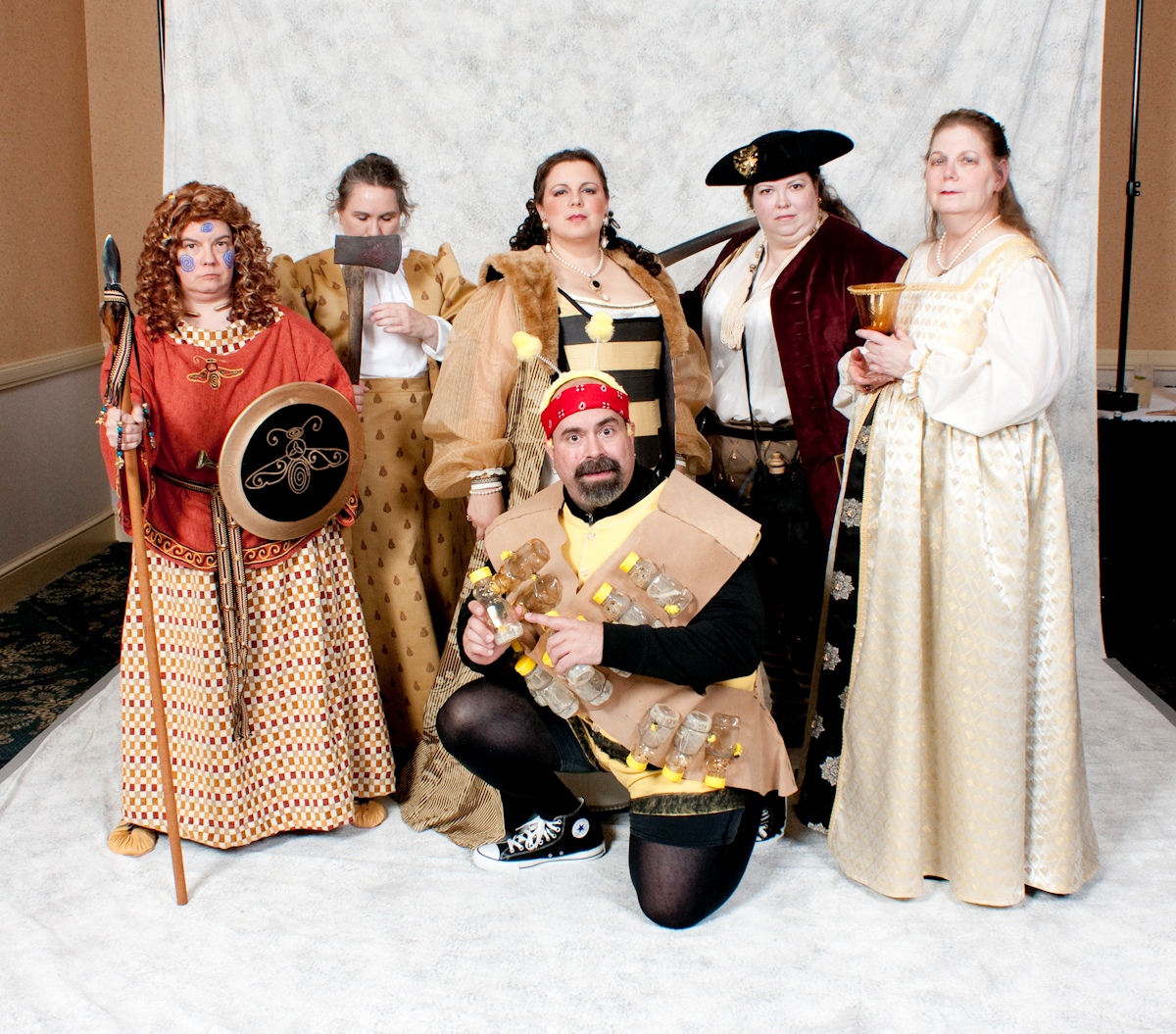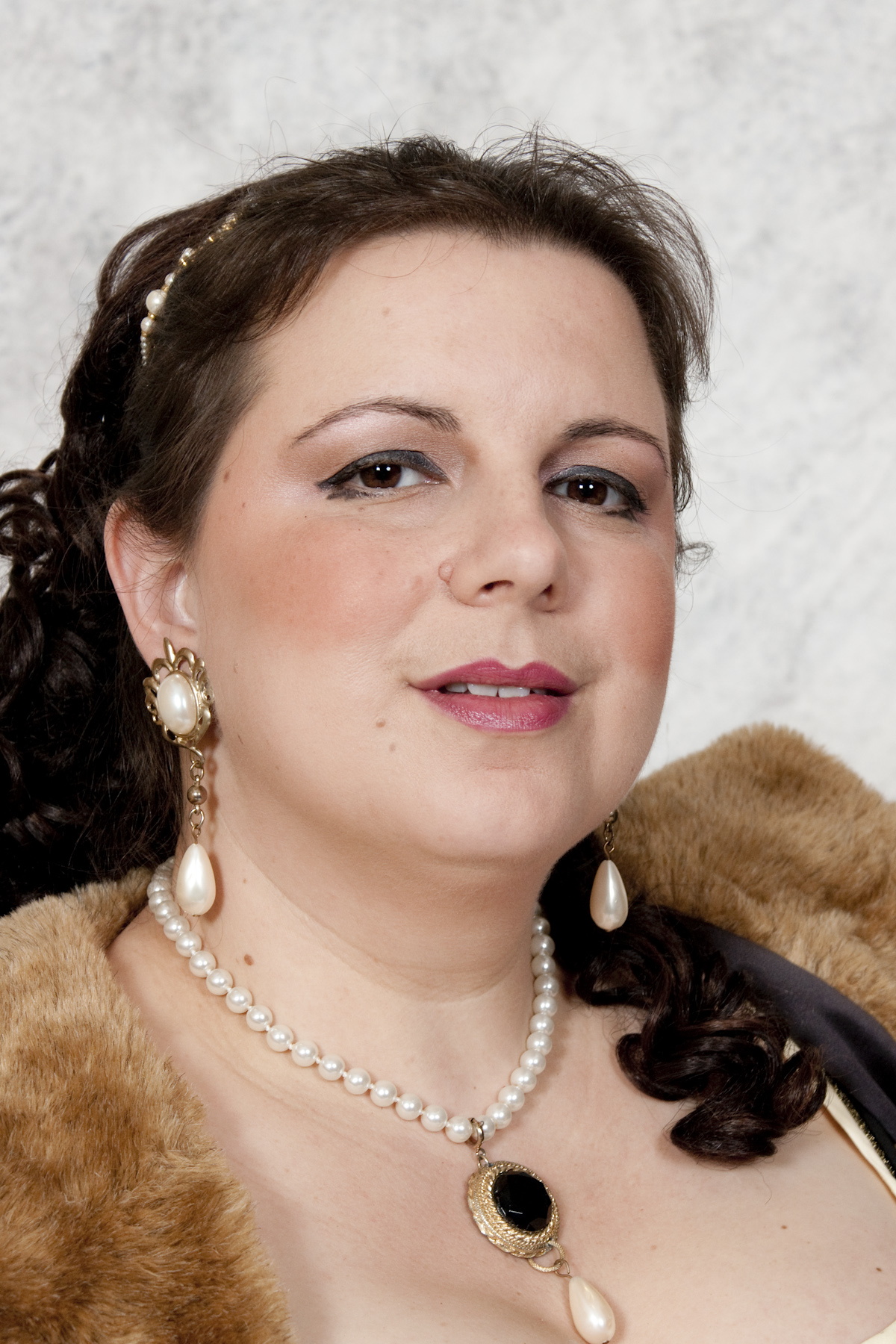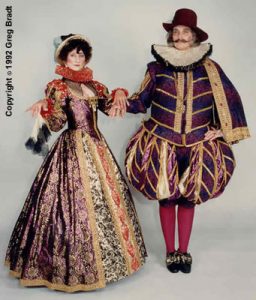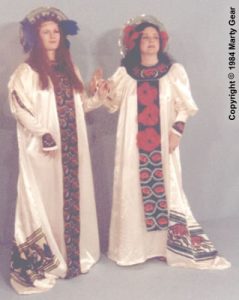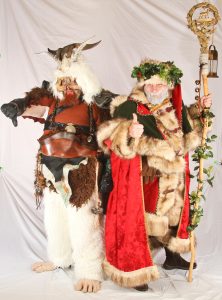CC27-H-23n: Killer Bs
Competition Staff & Rules
Staff:
- Director: Judy Mitchell
- Master of Ceremonies: Carl Cipra
- Presentation Judges: Kathe Barrows‡, Ann Catelli and Susan Toker; Judges’ Clerk: Jan Price‡
Rules:
The Costume-con 27 Historical Masquerade recognizes creativity, scholarship, stage presentation and workmanship skills in the context of historical clothing. It celebrates the history of costume, including all cultures, periods, and types of dress. “Historical costume” is costume based on clothing that was worn or could have been worn somewhere in the world.
-
The Historical Masquerade will limit entries to costumes based on clothing that was worn, or could have been worn, through December 31, 1959
-
The Historical Masquerade will take place on Sunday May 3, 2009. To enter the CC27 Historical Masquerade you must be a member of CC27, as must any models you may choose to use.
-
All entries are encouraged to pre-register. There will be at-the-con registration, but pre-register even if you only think you’ll have a garment completed in time. Each entrant is asked to circle the appropriate date of the costume on the Registration Form (Time Period). If each costume in a group entry has a different time period, circle all the appropriate dates.
-
The Masquerade will follow the International Costumers’ Guild Guidelines for International-Level Masquerades, or Competitions.
Competition Categories
Entries in all categories are eligible for Best in Class and Best in Show. The Historical Masquerade will have three categories of entry:
A. Historical Dress is for a costume that is intended to look like it came from a particular period of history. This includes costumes copied from a specific artwork or surviving garment, original costumes meant to look as if they were designed and made in a particular period, and everything in between. It is acceptable to use modern approximates for period materials for reasons availability, cost, or safety; these approximations should be noted in documentation. Modern Sewing is allowed.
B. Historical Interpretation is for a costume that intentionally and visibly departs from the period on which is it based. It ought to be obvious to the viewer that this costume was not intended to be totally authentic. If the judges have to ask what makes your costume an interpretation, it probably belongs in Historical Dress. The distinction between these two categories is based on the costume’s intent, not its execution.
C. Ethnic Costume or Dress may be of any period (including present).
Skill Levels
Skill definitions:
A. Young Fan: this level is limited to entrants younger than 13 years of age. It will be divided between entries made by a young fan and entries made by an adult that a young fan presents.
B. Novice: the Novice level is to encourage beginners. You may not enter at the Novice level if you
-
-
-
-
have won two awards at the Novice level in a Costume-Con historical masquerade
-
have won Best-in-Class in the Novice category or a Best-in-Show at a Costume-Con historical masquerade
-
have won at a level higher than Novice in a Costume-con historical masquerade
-
compete at the Master level in Science Fiction and Fantasy masquerades at Costume-Cons or World Science Fiction Conventions (these are the ICG-recognized “international-level competitions”)
-
have a costume Laurel or
-
are a professional. Professional is defined as someone who earns a majority of his or her income from fashion or costume, including college or university faculty members.
-
-
-
C. Journeyman: the Journeyman level is an intermediate level to allow further development of costuming skills. You may not enter at the Journeyman level if, at a Costume-Con historical masquerade you
(1) have won four awards at the Journeyman level
(2) have won Best-in-Class at the Journeyman level or Best-in-Show
(3) have won an award at the Master level
(4) have a costume Laurel or
(5) are a historical costume professional (as defined above).
D. Master: This is an ‘open’ level. anyone may enter and compete at this level if they wish. You must enter at this level if you are not eligible to enter as a Young Fan or at the Novice or Journeyman levels.
-
A contestant may enter at a level higher than the one for which he or she qualifies. However, an entrant who then wins at that level may not subsequently compete at a lower level. If in doubt over the level at which to compete, consult the Director.
-
A group entry will be assigned to a skill level based on its most experienced member.
Awards:
Our judges will make awards in three areas:
Entries will be judges against what the judges see as the award-winning standard. This means that you will not be competing against anyone else. The judges are not obliged to award Best-in-Class or Best-in-Show if, in their opinion, no entry meets the standards for those awards.
A. Documentation: Every entry in the Historic Dress category MUST have some documentation. For entries in the Historic Interpretation category, documentation is OPTIONAL: you may submit documentation for judging, or omit it, as is your choice. However, IF YOU OMIT DOCUMENTATION, YOU WILL NOT BE ELIGIBLE FOR AN AWARD IN THIS CATEGORY. All documentation must be turned in to the masquerade registration desk by 8:00pm Friday of the Con. If you are arriving at the con later, please contact me well in advance.
-
Basic Documentation: The basic requirements include:
a. Title of costume
b. Name and address of the person responsible for the entry (or spokesperson for a group)
c. Name(s) of designer(s) and maker(s)
d. Brief identifying description of the costumer’s historical period, geographic origin, social class, and so forth.
e. Bibliography of sources
The “brief identifying description” should include evidence of the historical basis for the costume. This could be as little as one photocopy of a single picture with an identifying caption or it could be more comprehensive. Assume that the judges are not familiar with the costume(s). You may wish to begin with a brief statement of what you are trying to accomplish and your rationale for choosing the project.
-
Advanced Documentation: In going beyond the minimal requirements, your documentation might include the following:
a. Pattern sources
b. Photocopies of visual sources, such as artworks, costume drawings, and sketches that you used (no originals, please)
c. Swatches of fabric and trim
d. Your own photograph(s) of original historical garments or accessories
e. Brief descriptions of any special skills or tools you used, such as shoemaking, weaving, or welding.
- Good Documentation (Basic or Advanced): Outstanding documentation demonstrates a comprehensive knowledge of the historical source(s) on which a costume is based, with rationales for all elements of the costume, including undergarments, accessories, and minor details, and explanations for deviations from the norm of the period. Excellent documentation also is organized logically and neatly, and presented attractively. Some contestants even go to the length of designing documentation in a style consistent with the costume.
-
Length of Documentation: Outstanding documentation is brief — long enough but no longer than you need to demonstrate the historical basis of the costume. Please be concise. Text (exclusive of bibliography and captions on illustrations) is limited to no more than four 8 1/2″ x 11″ typed double-spaced pages per costume. (In a group entry, each costume may have up to four pages of text). There is no page limit on captioned photographs and illustrations, fabric swatches or other samples, references, or bibliography.
-
The following will not be accepted as part of documentation: original sources, including books and paintings (make copies), slides, computer files, and video (tape/CD/DVD etc).
B. Workmanship and Detail Judging (“Pre-judging”): this part of the competition is REQUIRED of all Historic Dress entrants, and is OPTIONAL for Historic Interpretation entrants. Again, all entrants may sign up for Workmanship and Detail judging but are not required to. However, IF YOU OMIT WORKMANSHIP JUDGING, YOU WILL NOT BE ELIGIBLE FOR AN AWARD IN THIS CATEGORY. This is your opportunity to let the judges admire your work up close. Each entry will meet by itself with the panel of judges to show off the costume. Entrants will be expected to show the judges all necessary parts of the costume. If there is an item or element of the costume you want the judges to note especially, be prepared to point it out to them. We recommend that you bring, rather than wear, the costume to the prejudging, so that the judges may handle and examine your work inside and out. However, if you decide to wear the costume to pre-judging, be prepared to have the judges look down your cleavage, under your skirt, or at your underwear.
Pre-judging time will be strictly limited, approximately five minutes and certainly no more than ten minutes per person. The schedule will depend on the number of entries received by close of registration. Contestants will have an opportunity to sign up in advance at masquerade registration for appointments with the judges.
C. Stage Presentation: ALL ENTRANTS, REGARDLESS OF CATEGORY, MUST APPEAR ON STAGE. Here is your opportunity to complete your illusion before an appreciative audience. Entries with one to six persons will be limited to a maximum of 60 seconds on stage. Entries with seven or more persons will be allowed up to 90 seconds. Please keep in mind that these are maximum, not minimum, lengths of presentation. Feel free to use less time. If you feel that the maximum allowed will not be enough time to show your presentation, the Masquerade Directors will be willing to listen to your argument and possibly allow more time, but that is at their discretion. The Masquerade Directors strongly believe in brief presentations-30 seconds normally should be sufficient to present a one-person entry to the judges and the audience.
Other Rules:
-
All the general stage presentation rules for Costume-Con 27 masquerades will apply.
-
Each contestant may appear only once on stage. You may enter another costume, but it must be on another body.
-
There must be some display of skill in creating and executing a design. No flagrant nudity; the masquerade is rated PG-13. The Judges will not award what Mother Nature created. Remember: no costume is no costume.
-
No purchased, rented, or inherited costumes may be shown in the masquerade.
-
Hall costumes may not be shown in competition. They may be displayed out of competition.
-
Costumes that have won major awards for presentation or workmanship at previous Costume-Con or Worldcon competitions (excluding Honorable Mention) are ineligible to compete for an award, but may appear out of competition.
-
No live animals (other than guide animals) may be used in the masquerade.
-
Your costume may not be made of or trimmed with messy substances (the “no Peanut Butter” rule). Nor may it use any other substance which could cause harm to another entry in the green room or following you on stage (ex: no handfuls of loose glitter).
-
No fire, flame, flashes, firecrackers, or explosions will be permitted. – no exceptions.
-
Costumes with electric power requirements must be self-contained — no extension cords.
-
Small children must be under the control of a responsible adult at all times (back stage as well as on stage).
-
Your costume must be completed before you get to the Green Room. No sewing, gluing, soldering, welding, or other construction work may take place int eh Green Room except the final assembly of large costumes and props — or unexpected repairs.
-
No Live microphone is available for entrants’ use; pre-recorded dialog or a script for the MC is encouraged. Please keep a script for the MC to no more than about 100 words. Do not expect to be heard ‘live’ from the stage — you won’t be.
-
We expect that tech will be able to use clean CDs as well as clean cassette tapes. Record tapes at the beginning of a standard, blank audiocassette, preferably on both sides, and cue up and label the A side. Label the CD or cassette with your name and the entry title — do not use commercially pre-recorded CDs or audio cassettes, dub the track you want separately. Bring several copies with you for back-up.
-
The default lighting will be stage dark, lights rise on entry, fade to black at exit. Other patterns may be arranged with tech
-
Following a presentation, the entrant(s), roadies, or ninjas must remove all props left on stage in a single pass.
-
Use of weapons on stage must be approved in advance by the Director.
-
Entrants and their roadies will be required to attend a tech rehearsal. Further information on schedules, including times for rehearsals and presentations, will come in future PRs.
-
The Green Room and back stage area are intended for entrants, roadies, and masquerade staff only. Entrants are asked not to invite other friends or family into the Green Room. Small children must be under the control of a responsible adult at all times (back stage as well as on stage).
-
Surprise the audience, but NEVER surprise the Masquerade Directors or Crew!!! If you are planning something unusual or unique, or if you would like to request an exception to any of the rules above, please contact the Masquerade Directors well in advance of the masquerade.
-
If you feel any or all of these rules don’t apply to you, you are wrong. You must convince the Masquerade Director to make an exception long before the masquerade. Offers of cash and/or chocolate will not help here either.
-
The Masquerade Directors have the full authority to eliminate anyone from the competition on the grounds of bad taste, danger to self and/or others, violation of the above rules, or any other reason deemed sufficient. There is no appeal. Offers of cash, chocolate, and/or shiny things will not help. Not even maple sugar candy.
If you have any questions, please contact:
Judy Mitchell, Historical Masquerade Director
[Removed]
Entrants and Awards
Historical Masquerade
Here’s the run list and the winners for the Historical. It was a privilege to be the director for it, there were so many incredible costumes in here! I’m just glad I wasn’t a) competing against any of you or b)judging.
#1 Jennifer Lima- Anne, Uncrowned (M)(HD)
#2 Elizabeth Caldwell – Eleanor De Toledo (N)(HD)
#3 Bethany Padron (worn by Maral Agnerian & JF Bibeu) – English Court Dress(J)(HD)
#4 Ellen Montgomery – Foundation 101 – (N)(I)
#5 Michael Bruno, Nora Mai, Karen Heim – The Beautiful People (M)(I)
#6 Prentice Beckett – A Hunting We Will Go (N)(HD)
#7 Jacalyn Stanley – Martha Washington at the Inaugural Ball (N)(I)
#8 Robert Moyer and Daniel E Fox – The Enigma (M)(I)
#9 Joseph Vattimo & Prentice Beckett (modeled by Gaia Eirich) (N)(HD)
#10 Stephanie Pool – Madame Guillotine (N)(HD)
#11 Jamila Sisco – Newly Into Money: Lady on the Town (N)(HD)
#12 Mary Alice Ladd – Masquerade Ball (M)(I)
#13 Katherine Caron-Greig – A Walk in the Park, 1869 (M)(HD)
#14 Morgan Hatfield – The Winter Evening Affair (N)(HD)
#15 Tarisa Walker & David Dunn – A Longing Glance (J)(HD)
#16 Anne-Marie Morin-Bérard, Lucie Fontaine, Maxime Pinard – Where’s Watson?(J)(I)
#17 Elizabeth Monroe – More Vain than a Peacock – (N)(ND)
#18 Erin & Katharine Delaney – Betsy and Tacy (J)(I)
#19 Sandy Swank‡ – Notes on America’s Favorite Pastime (J)(I)
#20 Sarah Skinner -Salome’s Sins (N)(I)
#21 Leigh Alexander – Diamond Fairy (N)(HI)
#22 Patricia Anne Buard‡ – Christian Dior for Vogue Patterns, 1959 (M)(HD)
#23 Clair Whitworth, Trudy Leonard, Fiona Leonard, Chrism Kronick, Caran
Wilbanks & Bill Kronick – Killer B’s (M)(I)
In the NOVICE Division:
For DOCUMENTATION-
Best in Class
Leigh Alexander
“Diamond Fairy”
For WORKMANSHIP-
Best Supporting Role for Underpinnings
Jamila Sisco
“Newly Into Money: Lady on the Town”
Exceptional Wig Craft
Pretice Beckett
“Miss Gideon’s Moment” and “A Hunting We Will Go”
Excellence in Beading
Sarah Skinner
“Salome’s Sins”
Excellence in Fork Pleating
Morgan Hatfield
“The Winter Evening Affair”
Excellence in Couching
Elizabeth Caldwell
“Eleanor of Toledo”
For PRESENTATION-
Best in Class
Stephanie Pool
“Madame Guillotine”
Honorable Mention – “Good Catch”
Gaia Eirich
“Miss Gideon’s Moment”
+++++++++++++++++++++++++++++
In the JOURNEYMAN Division:
For WORKMANSHIP-
Best in Class
Anne-Marie Morin-Bérard, Lucie Fontaine, Maxime Pinard
“Where’s Watson?”
Best Costuming for the Theater
Bethany Padron
“English Court Dress”
Excellence in Hand Detailing
Ellen Sheffield Wilds
“Betsy and Tacy”
Excellence in Cascade Pleating
Tarisa Walker
“A Longing Glance”
For PRESENTATION-
Best in Class
Anne-Marie Morin-Bérard, Lucie Fontaine, Maxime Pinard
“Where’s Watson?”
Best Period Manners
Tarisa Walker
“A Longing Glance”
Best Characterizations
Erin and Katharine Delaney
“Betsy and Tacy”
++++++++++++++++++++++++++++++++++
In the MASTER Division:
For DOCUMENTATION
Honorable Mention
Patricia Anne Buard‡
“Christian Dior for Vogue Patterns, 1959”
For WORKMANSHIP
We Like Your Pants
Michael Bruno
“The Beautiful People”
Exceptional Frills and Furbelows
Katherine Caron-Greig
“A Walk in the Park, 1869”
For Her “Bonney” Coat
Chrism Kronick
“The Killer Bs”
For PRESENTATION
Most Compelling
Jennifer Lima
“Anne, Uncrowned”
Best in Class
Clair Whitworth, Trudy Leonard, Fiona Leonard, Chrism Kronick, Caran Wilbanks, Bill Kronick
“Killer Bs”
++++++++++++++++++++++++++++++++++++++++++++++++++++++++++++
BEST IN SHOW (Tie)
Patricia Anne Buard‡
“Christian Dior for Vogue Patterns, 1959”
Leigh Alexander
“Diamond Fairy”
BEST IN SHOW – DOCUMENTATION
Sandy Swank‡
“Notes on America’s Favorite Pastime”
